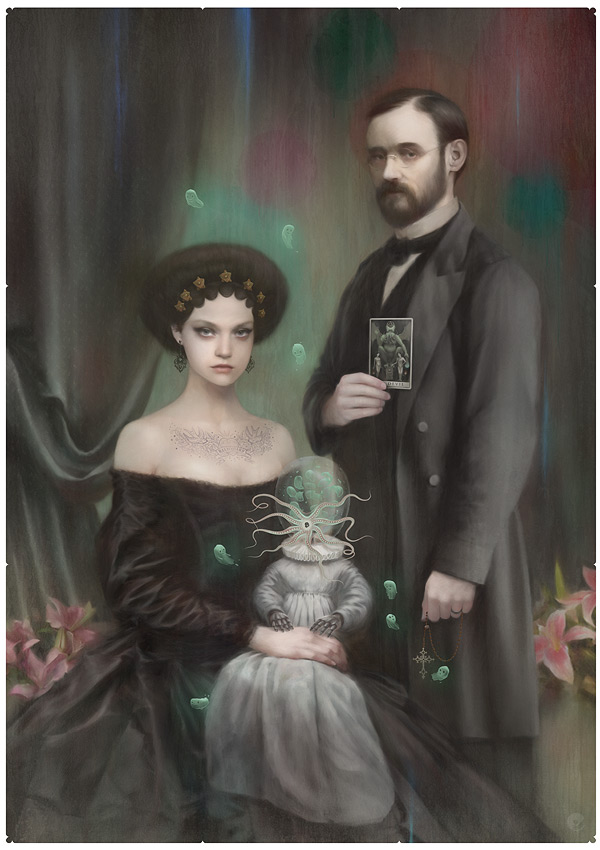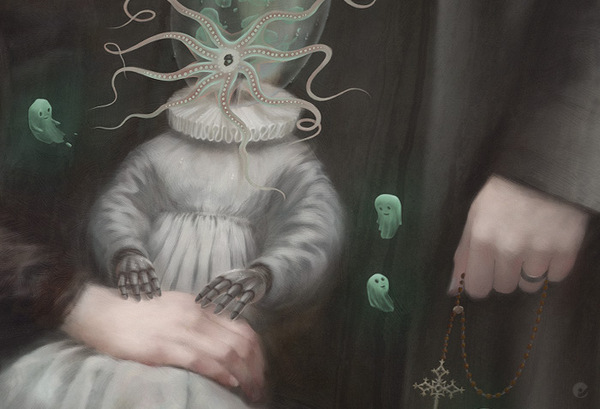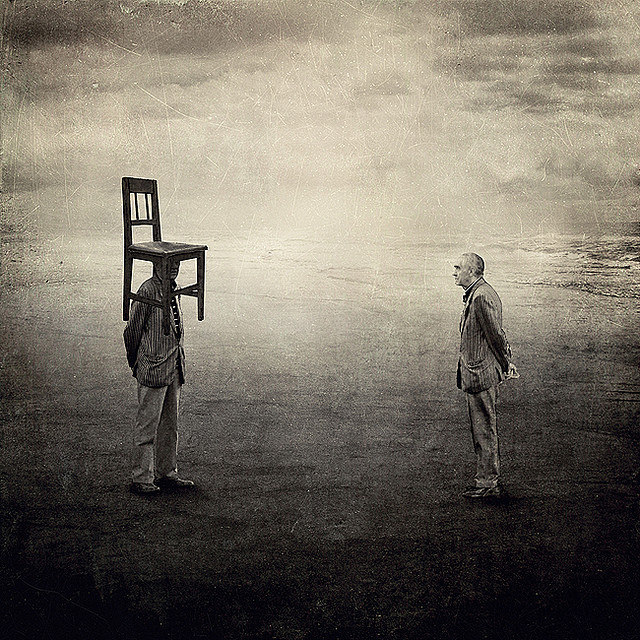Surrealism
Sarolta Ban via Surrealism Today
via Surrealism Today
Sarolta Ban ii via Surrealism Today
via Surrealism Today
On Symbolism
Symbolism
From Wikipedia
Symbolism was a late nineteenth century art movement of French and Belgian origin in poetry and other arts.
Precursors and origins
Symbolism was largely a reaction against Naturalism and Realism, movements which attempted to capture reality in its particularity. These movements invited a reaction in favor of spirituality, the imagination, and dreams; the path to Symbolism begins with that reaction.
//
Distinct from the Symbolist movement in literature, Symbolism in art represents an outgrowth of the more gothic and darker sides of Romanticism; but where Romanticism was impetuous and rebellious, Symbolist art was static and hieratic.
Movement
The Symbolist Manifesto
Symbolists believed that art should aim to capture more absolute truths which could only be accessed by indirect methods. Thus, they wrote in a highly metaphorical and suggestive manner, endowing particular images or objects with symbolic meaning. The Symbolist manifesto (�Le Symbolisme�, Le Figaro, 18 Sept 1886) was published in 1886 by Jean Mor�as. Mor�as announced that Symbolism was hostile to “plain meanings, declamations, false sentimentality and matter-of-fact description,” and that its goal instead was to “clothe the Ideal in a perceptible form” whose “goal was not in itself, but whose sole purpose was to express the Ideal”:
In this art, scenes from nature, human activities, and all other real world phenomena will not be described for their own sake; here, they are perceptible surfaces created to represent their esoteric affinities with the primordial Ideals.
//
In painting, Symbolism was a continuation of some mystical tendencies in the Romantic tradition, which included such artists as Caspar David Friedrich, Fernand Khnopff and John Henry Fuseli and it was even more closely aligned with the self-consciously dark and private movement of Decadence.//
The Symbolist painters mined mythology and dream imagery for a visual language of the soul, seeking evocative paintings that brought to mind a static world of silence. The symbols used in Symbolism are not the familiar emblems of mainstream iconography but intensely personal, private, obscure and ambiguous references. More a philosophy than an actual style of art, the Symbolist painters influenced the contemporary Art Nouveau movement and Les Nabis. In their exploration of dreamlike subjects, symbolist painters are found across centuries and cultures, as they are still today; Bernard Delvaille has described Rene Magritte’s surrealism as “Symbolism plus Freud”.
I love Symbolist art the most out of any genre, and though I’m not sure about the aims of those artists to “clothe the ideal in perceptible forms” which is “only accessible through indirect means,” (that sounds almost dogmatic) I am interested in some of the more esoteric topics, but simply put, I love art that depicts fantasy worlds.
It comes down to that. That whether it’s a few of Dali’s paintings, or Magritte’s, or Jacek Yerka, I love dream worlds, fantasy worlds, the inexplicable, painted in a way that looks as if you could almost walk into that reality.
To really get into that sort of work I have to feel like there’s something below the surface; a girl with fairy-wings in a forest may look nice, but I have to wonder about it. When you really get curious about a picture and want to know more about that world, you’ve hit the “hook point.”
It’s analogous to the hook in a good song, or a bad commercial. You get the melody in your mind and your brain starts to play it over and over. I’ve heard that referred to as “brain-itch.” But that sounds like someone needs some ointment or at least a different description for that.
In a good picture it’s that part where the artist gives you just enough that you want more but not too much that everything is explained.
And then the artist gets the question; “…but what does it mean?” I haven’t found a good answer to that.
Recently I’ve been alternating between:
- If I could say it, I wouldn’t have to make the picture.
- What do you think it means?
Often artists make pictures because we don’t have the words.
If you can think of any other good answers to “what does it mean?” let me know.
Dali's use of language in "On Modern Art"
Dali uses a number of techniques frequently throughout On modern art, to achieve his surrealistic style and tone. Some of these are (1) surrealist logic, (2) metaphor, and (3) paradox and reversal.
In his surrealist logic, his reasoning does not logically lead from one point to another, it just leaps from premise to assertion, or from assertion to assertion without any tight linear connection, and certainly without a deductive connection. His work still maintains a unity through an over-the-top tone. In part this tone is achieved through the flamboyant use of adjectives and concepts that is his trademark.
He uses unexpected metaphors though out the book to prove points.
He uses paradox and reversal often, both of which are common in comedy. Often in the case of his use of paradox he exploits the fact that all generalizations destroy themselves at some point in time–including that one. Reversal is when you think the story is going one way and then an amusing twist switches where you thought you were going to somewhere completely different.
Examples
- Surrealistic logic: “Everyone knows that intelligence only leads us into a fog of skepticism, that its chief effect is to reduce us to factors having a gastronomical and supergelatinous, Proustian and gamely uncertainty.” (pg. 9)
- Paradox: “… any attempt at a historical elucidation concerning it (modern art) would encounter the greatest difficulties, especially by reason of that contradictory and rare collective sentiment of ferocious individualism that characterizes its genesis.” (pg. 35)
The following sentence uses all three:
- “Because it so happens that the critics of the very antiquated modern art–who come from more or less central Europe, in other words from nowhere–are letting their most succulently Rabelaisian ambiguities and their most truculently Cornelian error of situation in speculative cookery simmer in the Cartesian cassoulet.” (pg. 13)
Big Picture
His writing style is over the top in a way that is congruent with his public persona and the boldness and irrationality of many of his paintings. There also seems to be an underlying structure of thought that is pervasive in much of his work; paintings, writing, and public persona. He achieves his irrationality in very systematic ways: not randomly, but through the repetitive use of illogical and nonlinear thinking.




